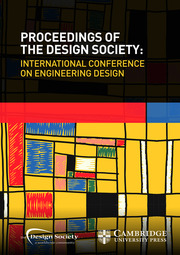Article contents
When Design Never Ends - A Future Scenario for Product Developement
Published online by Cambridge University Press: 26 July 2019
Abstract
One of the foundations of product design is the division between production and design. This division manifests as designers aspiring to create fixed iconic archetypes and production replicates endlessly in thousands or millions. Today innovation and technological change are challenging this idea of product design and manufacturing. The evolution of Rapid Prototyping into Additive Manufacturing (AM), is challenging the notion of mass manufacture and consumer value. As AM advances in capability and capacity, the ability to economically manufacture products in low numbers with high degrees of personalisation poses questions of the accepted product development process. Removing the need for dedicated expensive tooling also eliminates the cyclical timescales and commitment to fixed designs that investment in tooling demands. The ability to alter designs arbitrarily, frequently and responsively means that the traditional design process need not be applied and because of this, design processes and practice might be radically different in the future. In this paper, we explore this possible evolution by drawing parallels with principles and development models found in software development.
- Type
- Article
- Information
- Proceedings of the Design Society: International Conference on Engineering Design , Volume 1 , Issue 1 , July 2019 , pp. 829 - 838
- Creative Commons
- This is an Open Access article, distributed under the terms of the Creative Commons Attribution-NonCommercial-NoDerivatives licence (http://creativecommons.org/licenses/by-nc-nd/4.0/), which permits non-commercial re-use, distribution, and reproduction in any medium, provided the original work is unaltered and is properly cited. The written permission of Cambridge University Press must be obtained for commercial re-use or in order to create a derivative work.
- Copyright
- © The Author(s) 2019
References
- 1
- Cited by


